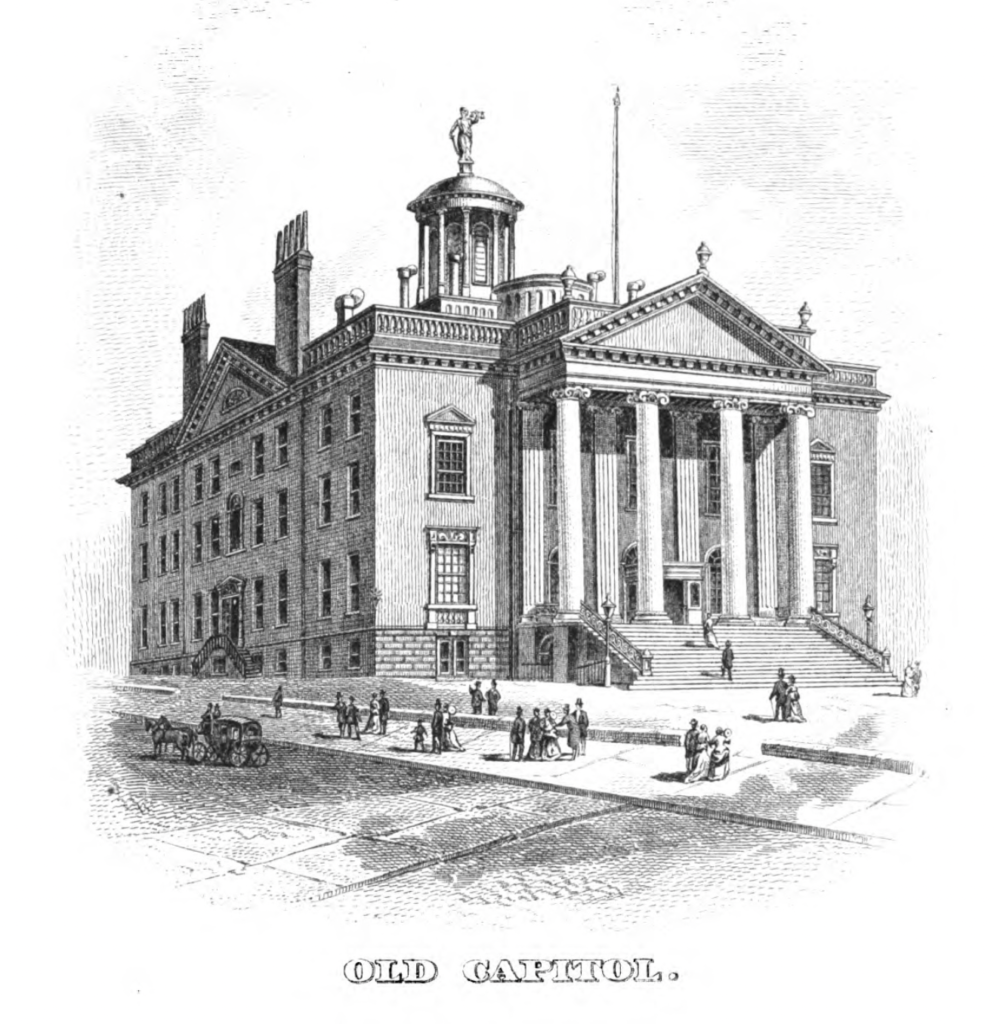
In 1854, Lippincott, Grambo & Company of Philadelphia published “A New and Complete Gazetteer of the United States.” It being 1854, the title wound on: “Giving a Full and Comprehensive Review of the Present Condition, Industry, and Resources of the American Confederacy: Embracing, Also, Important Topographical, Statistical, and Historical Information from Recent and Original Sources; Together with the Results of the Census of 1850, and Population and Statistics in Many Cases to 1853.” We can only surmise that the authors, Thomas Baldwin and J. Thomas, M.D., wished to present a challenge to librarians in fitting all that on an index card. (By the way, in 1854, “confederacy” didn’t mean what it would come to mean just a few years later.)
In that Gazetteer, if we may be so curt, are descriptions of both the county and city of Albany. Of the city, the Gazetteer said, “As viewed from some parts of the Hudson, the appearance of the city is highly picturesque and imposing . . . Albany, compared with most other American cities, is not remarkable for the regularity of its streets, nor generally speaking for the neatness or elegance of its houses; nevertheless, it contains many handsome, and several splendid edifices.
It gives a substantial description of the Capitol, not yet known as the “Old Capitol”:
Among the principal edifices of Albany may be mentioned the capitol, a substantial and handsome stone building 115 feet long, and about 90 feet wide; the walls are about 50 feet high, consisting of two stories and a basement story of 10 feet; it is faced with brown freestone from the quarries on the Hudson below the HIghlands. The columns, pilasters, and other decorations are of marble, chiefly from Berkshire, in Massachusetts. The edifice is crowned with a dome on which stands a statue in wood of the goddess Themis, (Justice,) 11 feet high, with a sword in her right hand and a balance in her left. The capitol contains an assembly chamber 56 feet long and 50 feet wide and 28 high, and a senate chamber 50 feet long, 28 feet wide, and the same in height, besides various other apartments. The capitol stands on the west side of the public square already alluded to. On the opposite side of the square, facing the west, is the state hall, a splendid edifice of marble, containing the different offices of the state government; on the same side is situated the city hall, a large and handsome building, also of marble, with a gilded dome.
The Gazetteer also mentions 40 churches, “many of which are handsome buildings,” and the Catholic cathedral, “not yet finished, [which] will probably be one of the most splendid as well as largest church edifices in the United States.”
Interestingly, it writes of the “University of Albany,” incorporated in 1852:
Albany is distinguished for her educational and literary institutions, among which may be mentioned the University of Albany, incorporated in 1852. This is intended to be national in its character, and of a higher order than any similar institution in the country; its object is to furnish the graduates of American colleges the means of completing an education without going abroad: its departments are of law, medicine, scientific and practical agriculture, civil and mechanical engineering, the mechanic arts, physical geography, political economy, history in its relations to civilization, chemistry in its application to the arts, and astronomy. A splendid observatory, connected with the university, to be called the Dudley Observatory, is now being erected at a cost of $25,000.
More on the University of Albany, which you’ve never heard of, tomorrow. The Gazetteer goes on to mention the State Normal School, established in 1844, the Albany Medical College (1839), the Albany Academy and the Female Academy, 11 public schools and the Albany Institute.
It also makes mention of all the city’s libraries. The Albany Medical College held 3000 volumes; the Normal School had 700. The public schools in all their libraries held 8050 volumes. The Albany Institute possessed a library of 5000 volumes, “in a flourishing condition.” The Young Men’s Association had a library of 8000 books as well as sponsoring a lecture series on literary and scientific subjects. The State Library held 27,000 volumes, and an Apprentices’ Library held 3000.
The city’s benevolent institutions were also named, including the Orphan Asylum, “which is liberally endowed, and provides for all the destitute orphans of the county,” and St. Vincent’s Orphan Asylum, a Catholic institution under the direction of the Sisters of Charity. The Emigrant’s Friend Society furnished protection and information to emigrants. “A society under the direction of a number of benevolent ladies was organized in December, 1850, for the purpose of giving fair and liberal prices to seamstresses; large numbers have been employed by the society, which is now in a most flourishing condition.”
In describing the advantageous positioning of the city with regard to the Erie Canal, the Hudson, and the railroads, the Gazetteer noted that Albany was probably the largest lumber market in the world, and that the value of lumber received here by the canal in 1852 amounted to $6,421,219. There was also $7.5 million worth of flour, $1.7 million worth of wool, $2 million worth of corn, as well as well more than a million dollars worth of each of wheat, barley, and unmanufactured tobacco. The total assessed value of real estate in the city was $15,831,630, and somehow they estimated personal property at $4 million. The population as of 1850 was 50,763.
